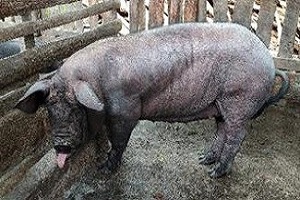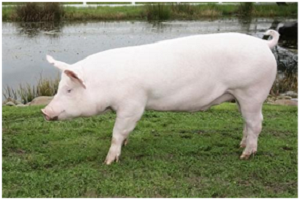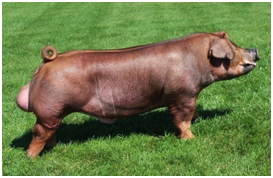Breeds of Pig
Success of pig farming is dependent on the selection of breed of pigs. Growth potential of the piglets depends on the nature and quality of the parent stock. The piglets that are produced must grow fast and produce quality carcasses with a high percentage of meat and a small quantity of fat. Few important traits for breed selection are:
- Litter size
- Size of weaned litter
- Strength and vigour of litter
- Mothering and milking ability
- Consistency of farrowing
- Feed efficiency
- Temperament
Boar should be selected from the litter of the sow that has high consistency of farrowing and high weaned litter. Under traditional pig farming system, the indigenous (desi) pig has been the breed of choice, but, these are small sized animals and they do not have any definite phenotypic characteristics. They have slow growth rate, produce small litters and the meat is also of inferior quality.
Comparison between native and exotic breeds
Choice of pig for commercial pig farming is mainly depend on the economic parameters of the pig. Generally, the exotic breed of pig is the foremost choice of the pig farmer to start commercial pig enterprises in India.
Comparison of economical parameters of exotic and indigenous breed
| S. No. | Economic Parameter | Exotic Breed | Indigenous Breed |
|---|---|---|---|
| 1 | Litter size at birth | 10 | 7.5 |
| 2 | Birth weight (Kg) | 1.4 | 0.91 |
| 3 | Weaning weight (Kg) | 13.5 | 4.1 |
| 4 | Weaning percentage (%) | 78.5 | 54 |
| 5 | Dressing percentage (%) | 68 | 66 |
| 6 | Maturity age (months) | 8-10 | 14 |
| 7 | Growth rate (gm/day) | >300 | 70-100 |
| 8 | Backfat thickness (cm) | 4-5 | 3-7 |
Selection of Breeds
- For commercial pig farming upgraded / crossbred or exotic stock in good health should be selected.
- While selecting a gilt or sow, primary aim should be to secure a female that will produce large survivable litter and which can attain marketable weight at an age of six months or less.
- Animals those are ready to be bred should be selected.
- Identify the newly purchased animal by giving suitable identification mark (ear notching or tattooing).
- Vaccinate the animals against diseases.
- Keep the animal under observations for a period of about two weeks and then mix with the other animals.
- Purchase animals in two batches at the interval of three months.
- Follow judicious culling and replacement of animals in a herd.
- Cull the old animals after 10-12 farrowings.
Breeding Boars Selection
The following are the important criteria for selection of boars for breeding purposes.
- They must be offspring of better producing gilts and sows.
- They must belong to litter with size and weight of not less than 8 and 72 kg respectively at weaning.
- Boars satisfying above stipulations are subjected to preliminary selection at 5 months of age provided they have a body weight of at least 60 kg.
- Final selection of boars should be undertaken at 7 months provided it has attained a body weight of at least 90 kg.
- Must be free from physical defects.
- Breeding males and females should be selected from different litters and boars should be changed periodically – preferably once in two years to avoid inbreeding.
Modern and well-established scientific principles, practices and skills should be used to obtain maximum economic benefits from pig farming.

Management of boars
- Although boars reach sexual maturity at 7 months of age, it is generally recommended that they must be at least 10-12 months (100 kg body weight) before being put to regular use.
- Boars should be fed after service rather than before.
- Boar: sow ratio may be 1:25.
- Outdoor exercise is good for keeping the boar thrifty and virile. He should neither be over fat nor run down. The boar may be handled firmly but gently, keeping in mind that he can be dangerous.
- Each boar should be housed separately.
- Number of services for boars: 2 - 4 per week depending on the age of boar.
- Boars should be tested for brucellosis and leptospirosis periodically.
Breeding Females Selection
Gilts: Breeding pigs are selected from mother pigs having good mothering ability as shown by large litter size and weight at weaning. Gilts should have 12-14 evenly spaced sound teats, good growth rate and feminity.
Weaned sows: Sows are usually weaned at 8 weeks after farrowing. The weaned sows come into heat in 3-10 days after weaning. They may be bred on the first post-weaning heat itself since this period is most fertile. She may respond to nutritious diet and pick up fast if the condition is poor.
Pregnant sows and gilts: In addition to having proper nutrition, the pregnant animals should be provided with regular exercise. Forced exercise may be brought about by feeding some distance away from the house or inducing the animal for moderate walk. Sows of the same size and condition can be run together. The bred and gilts may be housed separately. Do not house boars along with pregnant stock. Avoid overcrowding, mixing of new and old stock, slippery ground and over exciting of pregnant pigs.
The indigenous pig has been the basis used for pig production for a long period of time. It is small in size. Indian breeds of pigs are popular only for meat production. Some important indigenous breeds are Desi and Ankamali. Improved breeds are now being used for grading up the form the basis for pig production in the rural areas.
Indigenous Pig Breeds
| Breed | Breeding Tract | Important Features |
|---|---|---|
| Agonda Goan (Gavthi Dukor) | Goa |
|
| Andamani | Andaman islands |
|
| Doom | Different districts of Assam |
|
| Ghoongroo | Different districts of West Bengal |
|
| Gurrah (Desi breed) | Different districts of Uttar Pradesh |
|
| Mali (Tripura Desi Pig) | Different districts of Tripura |
|
| Niang Megha (Meghalya Local, Khasi Local) | Meghalaya |
|
| Nicobari (Ha-un/Naut) | Andaman & Nicobar |
|
| Purnea (Vananchal Black) | Different districts of Bihar and Jharkhand |
|
| Tenyi Vo (Votho, Naga Local, Suho) | Nagaland |
|
| Zovawk (Mizo local) | Different districts of Mizoram |
|
| Ankamali | Different districts of Kerala |
|
| Banda | Jharkhand |
|
| Manipuri Black | Manipur |
|
| Wak Chambil | Meghalaya |
|

Ankamali

Ghungroo

Banda Pig

Manipuri Black Pig
Cross Breeds of Pig
- Breeding of our local pigs with exotic breed to produce good offspring is called crossbreeding. The crossbred pigs have inherited productive traits equally both from exotic and local breeds.
- The first generations of cross bred pigs are called F1 Cross. Then the F1 cross pigs are further crossed with other F1 generation pigs and the progenies is called F2 generation crossbred pigs which are upgraded pigs. These crossbred pigs inherit productive favorable characters or traits from local breed pigs such as their hardiness to survive unfavorable situations adjusting to climatic conditions, disease resistance, consuming low quality local available feedstuffs such as tubers, sweet potato, left over broken grains and convert them into high quality and quantity of meat pork.
- They also inherit many characters or economic traits from exotic breeds such as large litter size, producing more number of piglets, good mothering ability with lesser mortality. The piglets also have good ability to grow faster with optimum feed conversion abilities.
- The crossbred pigs attain quick and fast growth. They attain body weight of 45-60 kg live body weight in 6 months with average daily gain of 400-500g per day. The average FCR is 2.75-3.00kg feed intake per kg weight gain.
- The female sows will come to heat fast with early maturity and produce first litter by 13-15 months of age and produce average 8-12 piglets. The crossbred pigs produce 72-75% pork (Dressing percentage). The mothers also produce good milk required for suckling piglets. They also protect the young ones from predators.
- Various efforts are being undertaken by the Central and State Departments; especially different Research Organizations like ICAR, CAU, SVUs/SAUs for genetic improvement of indigenous pigs based on farmer’s choice and suitable for commercial piggery farming. Subsequently, crossbreeding of indigenous pigs with the exotic boars resulted in the development of crossbred pig varieties suitable for the different agro-climatic conditions of the country.
The crossbred pig varieties are as follows:
| S. No | Name of the Crossbred Pig Varieties | Characteristics | Name of the Developing Organization/Institute |
|---|---|---|---|
| 01 | Rani | This pig variety has 50% Hampshire (exotic breed) and 50% Ghungroo (indigenous breed) inheritance. This pig gains almost 75 kg body weight at slaughter age of 8 months with 1.98 cm of backfat thickness. | ICAR – National Research Centre on Pig, Guwahati, Assam |
| 02 | Asha | This pig variety has 25% Ghungroo, 25% Hampshire (exotic breed), and 50% Duroc (exotic breed) inheritance. This pig variety can produce 80 kg lean pork at slaughter age of 8 months with 1.75 cm backfat thickness. | ICAR – National Research Centre on Pig, Guwahati, Assam |
| 03 | HD-K75 | This pig variety has 75% Hampshire (exotic breed) inheritance and 25% indigenous inheritance of local pigs of Assam. This pig variety attains almost 74 – 80 kg body weight at slaughter age of 8 months with 1.75 - 2.58 cm of backfat thickness. | All India Coordinated Research Project on Pig, Assam Agricultural University at Khanapara, Guwahati, Assam |
| 04 | Jharsuk | This pig variety has 50% Tamworth (exotic breed) and 50% local pigs of Jharkhand inheritances. This pig variety attains approximately 80 kg body weight at slaughter age of 8-10 months. It can produce 8-12 piglets in each farrowing with two farrowing each year. | All India Coordinated Research Project on Pig at Birsa Agricultural University, Ranchi |
| 05 | Mannuthy White | This pig variety has 75% Large White Yorkshire (Exotic) and 25% Desi (Local) pig of Kerala inheritance. The crossbred pig variety attains 94 kg body weight at slaughter age of 10 months and 2.10 cm of backfat thickness. | All India Coordinated Research Project on Pig at Kerala Veterinary and Animal Sciences University, Mannuthy, Kerala |
| 06 | Lumsniang | This crossbred pig variety has Hampshire (Exotic) and Niang Megha pig of Meghalaya inheritance. The pig variety attained a higher body weight of 90-100 kg at 12 months of age, besides higher litter size at weaning as compared to local non-descriptive pigs’ (8.56±0.77 vs 5.23±0.54). | All India Coordinated Research Project on Pig at ICAR-Research Complex for NEH Region, Barapani |
| 07 | TANUVAS KPM Gold | This pig variety has 75% Large White Yorkshire (Exotic) and 25% Desi pig of Tamil Nadu inheritance. The pig variety attains 72 kg body weight at 8 months with 8.09 litter size at birth. | All India Coordinated Research Project on Pig at PGRIAS, Kattupakkam |
| 08 | SVVU-T17 | This pig variety has 75% Large White Yorkshire (exotic breed) and 25% Desi pig of Andhra Pradesh inheritance. This pig variety attains 85.48 kg body weight at slaughter age of 10 months with 8.1 litter size at birth. | All India Coordinated Research Project on Pig Centre of Sri Venkateswara Veterinary University (SVVU), Tirupati |
| 09 | Landlly | This pig variety has 75% Landrace (exotic) with 25% Gurrah pig (local) inheritance. This pig variety attains marketable weight at the age of 8 months. | AICRP on Pig Centre of ICAR-Indian Veterinary Research Institute (IVRI), Bareilly |
• There are few other crossbreeds like Thus, the study was carried out to evaluate the performance of crossbred pigs viz., Tamworth X Desi (T&D), Hampshire X NiangMegha (H&NM) etc. to popularize crossbred pigs and enhance productivity.
Exotic Breeds
1. Large White Yorkshire
The large White Yorkshire is a popular English Bacon breed, which had its origin Yorkshire and neighboring countries in northern England.
- Yorkshire sows are noted as good mothers.
- Bacon type breed
- Most extensively used exotic breed in India
- Body colour is solid white with occasional black – pigmented spots (‘freckles’)
- Erect ears, snout of medium lengths and dished face
- Excellent breed for the purpose of cross breeding
- Prolific breeds
- Mature boar 300-400 kg
- Mature sow 230-320 kg

Large White Yorkshire
2. Middle White Yorkshire
- This breed was evolved by crossing the Large White Yorkshire with smaller breed of Yorkshire extraction.
- Used in some areas in India
- Grows rapidly gives good dressing percentage
- Not so prolific as large white Yorkshire
- Males 250-340 kg
- Females 180-270 kg
- Extensively used to upgrade desi pigs as it is smaller in size.

Middle White Yorkshire
3. Landrace
The origin of this breed is Denmark, where it has been bred and fed to produce the highest quality bacon in the world.
- Large, long body. The breed is white in colour, although black skin spots ‘freckles’ rather common.
- White bristles in white body
- The breed is characterized by its long, deep side; square ham. The legs are relatively short .The carcass is more lean than that of the meat.
- Matured body weight boar 270-360kg and sow 200-320kg.


Landrace
4. Duroc breed
It is native of America. But, it was developed in Denmark and later imported to India.
- The animals are red colour with red mixed black patches and brown stripes with heavy and large sized body.
- The sow produces lesser number of piglets but has good mothering ability. The meat is nutritious and tasty.
- The pig can be used for crossbreeding and upgrading of the local breeds. The adult attains 270kg in span of 2 years.

Duroc Breed
Economic Traits
- Litter Size
- Weight at Birth.
- Weaning Weight.
- Litter size at Weaning.
- Growth rate:
- Birth to Weaning : Weaning wt.- ¬¬–birth wt./ 56
- Weaning to 154 days: Weight at 154 days-Weaning weigh/ 98 days
- Weight at 154 days to 210 days : Wt.at 210 days- Wt. at 154 days / 154 days.
- Feed efficiency: Feed consumed per of kg of live weight.
- Mortality percentage.
Comparison between Desi V/s. Exotic breeds (India)
| Desi | Exotic | |
|---|---|---|
| Litter size at birth | 7.5 | 10 |
| Birth weight (Kg) | 0.91 | 1.4 |
| Weaning weight (kg) | 4.1 | 13.5 |
| Weaning percentage | 54 | 78.5 |
| Dressing percentage | 66 | 68 |
| Maturity (Months) | 14 | 8 - 10 |
| Growth rate (gm) | 70-100 | over 300 gm |
| Back fat thickness (cm) | 3-7 | 4-5 |

